Before the crisis, when people had more money than sense, some brands made a concerted effort to go up market, increasing their average price, without increasing their value at the same time. Sure, during the hey-day of the watch industry, they were able to get these new, inflated prices, but now, however, it’s a different story. These brands are struggling and many are coming back down to their original price range or lower, accepting the fact that higher priced sales are much harder to come by in this new reality.
Europa Star talked to five brands that stayed true to their legacy of value and reasonable prices, to get a sense of how things are going for them: Hamilton, Oris, Frederique Constant, Raymond Weil and Victorinox Swiss Army. Here’s what they had to say:
Hamilton
Hamilton has long been a leader in the mid-range price segment and brand President Matthias Breschan has used the crisis to strengthen Hamilton’s position and to gain market share. “Hamilton has more than tripled its turnover over the past five years,” he says. “The brand offers a ‘real value’ for its price - certainly a big asset in the current market environment. Our enormous success in recent years has been based on our unique offer of automatic watches with strong character at a ‘democratic’ price between five hundred and two thousand dollars.
“The unique shape, attention to detail, the combination of Swiss technology with the American spirit and the strong design of the watches give Hamilton a distinctive and attractive brand identity,” he continues. “Hamilton gained significant market share in all countries reinforcing its position as worldwide market leader for mechanical watches in this segment. Despite the crisis we have been approached by a lot of new, higher-end retailers that would like to carry the brand.”
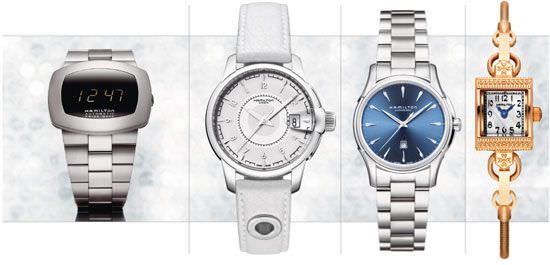
PULSOMATIC, RAILROAD MEDIUM, JAZZMASTER and LADY HAMILTON REPLICA by Hamilton
Hamilton isn’t going to be changing its strategy anytime soon. “Our priority is not to expand rapidly but to grow in a controlled and qualitative way,” Breschan details. “We would never sell products in many points of sales simply for a quick profit – it wouldn’t be healthy in the long-term. We concentrate on the brand’s image, perception and positioning.
“We plan to strengthen our leading position for automatic watches in all key markets in the middle price segment,” he continues. “In 2010 we will introduce the new Pulsomatic to celebrate the fortieth birthday of the world’s first digital watch, made by Hamilton, in 1960. This year, our new women’s watches equipped with automatic movements will also attract a lot of attention, with their creative blend of features usually associated with our men’s watches and a subtly feminine charm. The new collection is a perfect bridge between our legacy and our future.”
When other brands are charging more than US$1,000 for steel quartz watches, you can understand the appeal of Hamilton during these tough economic times. The brand offers real value for real watches.
Oris
According to Mark Wasserman, President of Oris USA, things have been tough for Oris through 2008 and 2009, though things are starting to look better. “In the US, this crisis really started a couple of years ago, in October 2007, that’s when Americans started feeling the pinch,” Wasserman explains. “We were dealing with order cancellations even back then, and it was very difficult. In November 2009, all of a sudden, the store inventories were lower, my inventories were lower, and sales really exploded. In fact, between November and December, I had two of the best booking months I’ve ever had. I am very enthusiastic. I expect this year to be much better than last year.”
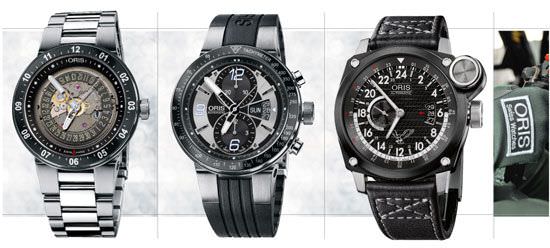
F1 TEAM SKELETON, F1 TEAM CHRONOGRAPH and BLUE EAGLES LIMITED EDITION by Oris
Wasserman attributes Oris’ strong perform-ance to their price point, which is 800 – 3000 CHF. “It’s still a strong market in that price range. “I believe consumers realize that Oris gives very good value. If someone spends 1,500 CHF on an Oris watch, it’s worth 1,500 CHF. It’s a good, solid, interesting mechanical watch. we have some unique, value-driven product. Within our price range, we believe that no one comes near us in quality. We have never wavered from our course of providing a fine mechanical watch at a very good price.”
One of the more interesting aspects of the crisis has been that retailers who never showed much interest in Oris have been approaching the brand. “The higher-end has suffered much more than the mid-range, so we have been approached by retailers we never dealt with before,” Wasserman admits. “Retailers used to look down on people spending 1,500 CHF on a watch, now they are appreciating them. That 10,000 CHF customer is not around any more.”
The only changes in strategy Oris made during the crisis was some belt-tightening. “From a business point of view, I cut back my expenses as much as I could, in order to deal with lower volume,” he says. “We all have a tendency, when things are good, to get a little fat. I cut back on a lot of areas. And, in the kind of economy we have had to deal with, we look at credit much more carefully.”
Raymond Weil
Though 2009 was a very challenging year, according to Raymond Weil President and CEO Olivier Bernheim, but he says that the brand achieved most of its objectives: maintaining its independence; adapting Raymond Weil’s new products to the end consumers’ needs; establishing its own distribution company, RW USA Corp in the United States and in India; and opening new exclusive boutiques in UAE, India, Saudi Arabia and Bulgaria.
“During the economic crisis, our goal was to ensure our position and to strengthen the business relations with our partners,” Bernheim explains. “I think we have been able to perform well during the crisis because of our capacities of reactivity, flexibility, innovation and anticipation generated by the major advantages of an independent and family-run company.”
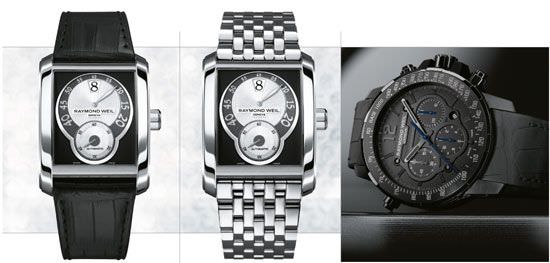
DON GIOVANNI COSI GRANDE, NABUCCO by Raymond Weil
The crisis has been, in some ways, good for mid-range companies because there is an increased focus on value and getting your money’s worth. “The economic crisis is very clearly marking a return to horological values and to products manufactured with a true savoir-faire,” Bernheim points out. “Raymond Weil anticipated this strong interest on the part of consumers and thus positioned its pieces at the heart of the traditional watchmaking segment.”
The need for retailers to get traffic into their stores has led many high-end retailers to come to Raymond Weil. “Many jewellers have realized how crucial it was for them to maintain a certain level of traffic within their doors,” he says. “Our price point and name, reputation and quality offers them the perfect proposal. We took steps two years before the crisis hit and we had already developed our product line-up around the ‘entry-level’ range – between 800 and 1,500 CHF. The arrival of the ladies collection Noemia as well as our new Tradition models, is the perfect illustration of advance planning that only a family business can undertake.”
Bernheim plans to stay the course in the future, committing to the brand’s current positioning. “Raymond Weil’s action plan is built on a long-term basis,” he explains. “Our vision for the upcoming years is to stay independent, dynamic and to consolidate our place in the exclusive world of luxury watchmaking. Our new products, which are very well adapted to the end consumers’ needs, and our very solid relationships with our business partners are important advantages that will help us to deal with the new market situation.”
Victorinox Swiss Army
Victorinox Swiss Army has been hit hard by the crisis, especially in the duty free business, which accounts for 15 per cent of the brand’s turnover. “In 2009, the first two quarters showed a negative record versus the previous year, but we managed to catch up during the third quarter and over-achieved 2008’s performance during the last quarter of 2009,” says Alexander Bennouna, CEO, Victorinox Swiss Army. “This performance enabled us to close the year 2009 almost at the same level as 2008.”
Bennouna says that Victorinox Swiss Army gained market share during the crisis, as customers turned to its value-oriented watches rather than more expensive competitors.
“Victorinox Swiss Army is still in an expansion phase especially in Europe and Asia,” Bennouna details. “Our development in these zones has slowed down a bit but is still showing a positive progression. Victorinox Swiss Army is a new, up and coming brand in the watch industry (with only a 20 year history) but with a long and rich history inherited via the legendary Swiss Army knife. Victorinox Swiss Army has managed to develop steadily while remaining consistent with the core values that created the success of Victorinox.
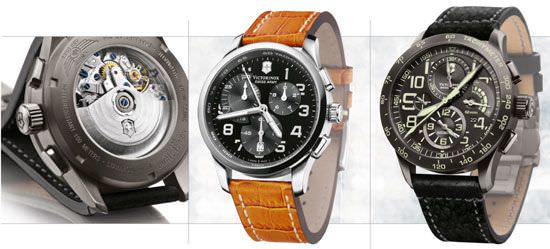
ALLIANCE CHRONO, AIRBOSS by Victorinox Swiss Army
“The values of the legendary and iconic Swiss Army knife – functionality, innovation and re-liability - speak to the end consumer who is willing to invest into a timepiece,” he continues. “By perpetuating those values in our timepiece collection, we provide a high level of technological performance at an accessible price.”
Victorinox Swiss Army, being a privately-held, family business, can afford to have a long term plan and vision. “As we have not capitalized on short term trends and opportunities, our company was less exposed to the financial downturn,” Bennouna says. “The end consumer, because of financial restrictions, has moved from an impulse buying attitude towards a more conscious buying attitude. Therefore, we can observe that the consumers have become more receptive to brands like Victorinox Swiss Army, offering a solid substance that goes beyond marketing statements.
“We are confident that we will pursue the international expansion we initiated five years ago, and we hope that, with the support of our valuable partners, we will be able to service more and more enthusiastic consumers,” he concludes.”
Frederique Constant
After the first quarter of 2009, Frederique Constant, according to President and CEO Peter Stas, has caught up to the levels of 2008. “We have been working on a strategy of accessible luxury, and this has really helped us get through the crisis,” he says. “Consumers are looking for classical models at accessible prices, and that is what we have supplied them.”
In fact, that’s how Frederique Constant was started, with Peter Stas and his wife founding the watch brand to provide quality watches at affordable prices. Today, more and more retailers are considering their brand. “High-end retailers, like Wempe, for example, see our brand as an additional segment for them to realize sales to consumers that cannot afford the high priced watches anymore.”
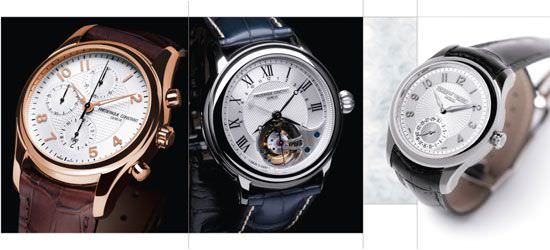
RUNABOUT, TOURBILLON and MAXIME by Frederique Constant
Stas feels relieved that he hasn’t changed his strategy since the start of his company in 1995. Other companies who raised prices before the crisis are now selling with big discounts on the Internet, he notes. “We are confident that our brand will grow 20 per cent in 2010,” he says. “Everything is ready to expand with a very good collection, accessible prices and a major push in publicity.”
As consumers look more closely at all purchases, mid-range brands’ combination of value, affordable prices and attractive timepieces is certainly inviting.
Source: Europa Star February-March 2010 Magazine Issue




